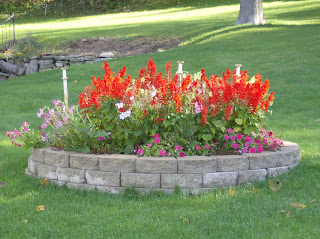
In the normal course of affairs, we can’t expect to see a lot of flower color in late October. This bold circle of red Salvia is the exception which proves the rule; I doubt it could look this good this late in the season (10/25/07, Adams) in one year out of ten.

A more typical level of October color would come from the berries on a female holly such as this one (Ilex, variety unknown, 10/26, North Adams), but this is an unusually pretty and heavily berried example, despite the lack of any obvious nearby male pollen partner.
Darwin
By design, fruit must follow flowers, so a plant is more likely to be fruiting than flowering in October. But fewer plants use flamboyant fruits for animal attraction than earlier used animals for pollination. This fruit strategy is common to shrubs and small trees, perhaps their greatest strength in the competition with forest trees and other woodland plants. Their berries are nutritious, at least for birds, and the plants use this fact to attract birds. The birds are often aided in their quest by the berries' bright color, frequently red. For the plants, birds' smaller digestive system and lack of molars mean the seeds will pass through the birds undigested. Bird mobility is of course also a positive. At the same time, many berried plants use strategies to keep from being eaten by larger land animals. Thorns are the best-known, but the toxin in poison ivy, whose seeds are meat for birds, and poison for mammals, is another such strategy. (Poison ivy's red leaves are a great attraction to birds, while its actual berries are off-white.)
Flamboyant Foliage
To get really large masses of bright color in October, we have to look to foliage, not flowers or berries, on plants which are themselves pretty massive. Of course, not all foliage is equal to the task. Evergreens generally have only subtle color changes, and with many deciduous plants even peak fall color is muddy or uninteresting. In other cases a shrub’s bright fall foliage is as ephemeral as are its spring flowers. (Even foliage is running perhaps two weeks later than average this year; but it certainly tends to run later than just about any reliable flowers, except for a few little bulbs such as Colchicums and fall crocuses.)
A number of vines have excellent reddish fall foliage. Poison ivy is perhaps the most beautiful. But leaving aside a few special needs, as in places where trespassers have driven one to misanthropy, there are more reasonable options such as the Boston ivy shown above (Parthenocissus tricuspidata, its specific name referring to its three-pointed leaves, 10/26, Williamstown), Virginia creeper (Parthenocissus quinquefolia, named for its groups of five leaflets), and grape plants (Vitis), which are in the same family as Parthenocissus (Vitaceae).
And of course, shrubs and trees which have red foliage all summer, such as this Japanese maple (Acer palmatum, looks like the ‘Bloodgood’ variety, 10/25, Adams) still have red foliage up until leaf fall – not as dramatic looking in fall when other plants are even brighter, but certainly providing a contrast to neighbors which might still be green, or turning yellow, orange or brown.
So, noting that vines are a niche item which needs the right backdrop and a support which is strong and undamaged by heavy shading, what is generally the best source of massive bright red fall color?
There are a number of shrubs which, like poison ivy, attract the eye with brilliant fall foliage. For example, for those of us with acid soil who are considering the blueberry (Vaccinium), fall foliage is just icing on the (edible) cake. But to me, the role of providing a large and dramatic colorful emphasis is best filled by the much-maligned, much-abused, and much-misused Burning Bush (Euonymus alatus, or Winged Euonymus or Winged Spindle). A common bush, found in parking lots, and sneered at by landscape architects who call it the “worst bush ever” you say? Indeed, all true. But it gets a bad rap, in my not-humble opinion. Where it is allowed to grow without heavy pruning or shearing it can be quite beautiful, wherever a spherical 10-foot bush can find at least partial sun, in all but the most extreme soil and water conditions.



